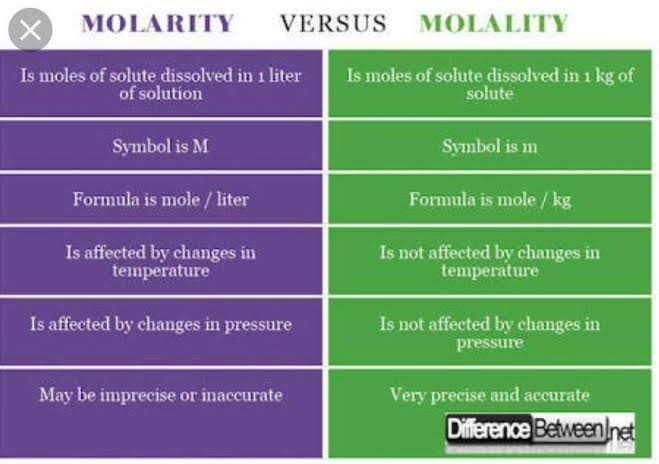Class 11 Exam > Class 11 Questions > What is difference between molarity and molal...
Start Learning for Free
What is difference between molarity and molality?
Most Upvoted Answer
What is difference between molarity and molality?
Molarity Vs Molality: Explained
Molarity
Molarity is defined as the number of moles of solute per liter of solution. It is represented by the symbol M and is expressed in moles per liter (mol/L).
Formula
Molarity (M) = Number of moles of solute / Volume of solution in liters
Characteristics
- It is temperature dependent
- It is affected by the change in volume
- It is used for solutions where the solvent is water
- It is used for reactions that occur in a solution
Molality
Molality is defined as the number of moles of solute per kilogram of solvent. It is represented by the symbol m and is expressed in moles per kilogram (mol/kg).
Formula
Molality (m) = Number of moles of solute / Mass of solvent in kilograms
Characteristics
- It is temperature independent
- It is not affected by the change in volume
- It is used for solutions where the solvent is not water
- It is used for colligative properties such as boiling point elevation and freezing point depression
Key Differences
- Molarity is expressed in terms of volume whereas molality is expressed in terms of mass.
- Molarity is affected by the change in volume whereas molality is not.
- Molarity is temperature dependent whereas molality is temperature independent.
- Molarity is used for solutions where the solvent is water whereas molality is used for solutions where the solvent is not water.
- Molarity is used for reactions that occur in a solution whereas molality is used for colligative properties such as boiling point elevation and freezing point depression.
Conclusion
Both molarity and molality are used to express the concentration of a solution but they differ in their characteristics and applications. Molarity is used for reactions that occur in a solution while molality is used for colligative properties such as boiling point elevation and freezing point depression.
Community Answer
What is difference between molarity and molality?

Attention Class 11 Students!
To make sure you are not studying endlessly, EduRev has designed Class 11 study material, with Structured Courses, Videos, & Test Series. Plus get personalized analysis, doubt solving and improvement plans to achieve a great score in Class 11.

|
Explore Courses for Class 11 exam
|

|
Similar Class 11 Doubts
What is difference between molarity and molality?
Question Description
What is difference between molarity and molality? for Class 11 2024 is part of Class 11 preparation. The Question and answers have been prepared according to the Class 11 exam syllabus. Information about What is difference between molarity and molality? covers all topics & solutions for Class 11 2024 Exam. Find important definitions, questions, meanings, examples, exercises and tests below for What is difference between molarity and molality?.
What is difference between molarity and molality? for Class 11 2024 is part of Class 11 preparation. The Question and answers have been prepared according to the Class 11 exam syllabus. Information about What is difference between molarity and molality? covers all topics & solutions for Class 11 2024 Exam. Find important definitions, questions, meanings, examples, exercises and tests below for What is difference between molarity and molality?.
Solutions for What is difference between molarity and molality? in English & in Hindi are available as part of our courses for Class 11.
Download more important topics, notes, lectures and mock test series for Class 11 Exam by signing up for free.
Here you can find the meaning of What is difference between molarity and molality? defined & explained in the simplest way possible. Besides giving the explanation of
What is difference between molarity and molality?, a detailed solution for What is difference between molarity and molality? has been provided alongside types of What is difference between molarity and molality? theory, EduRev gives you an
ample number of questions to practice What is difference between molarity and molality? tests, examples and also practice Class 11 tests.

|
Explore Courses for Class 11 exam
|

|
Suggested Free Tests
Signup for Free!
Signup to see your scores go up within 7 days! Learn & Practice with 1000+ FREE Notes, Videos & Tests.

























